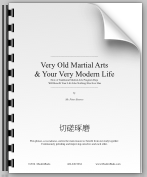I’ve talked with lots of educators and coaches, and read some of the research from top researchers and sports psychologists … and even inadvertently ran an eight year experiment in how curriculum design affects martial arts students.
Defining Terms
- Curriculum:
-
- Generally everything in your collection of knowledge to teach
- The specific requirements to reach a certain educational goal
Which one of those are you using as your starting point? Either one is a valid choice. If you take all of your general information, you can find a way to get all of it taught, and even taught well, to your students, though they might not hit a particular milestone at a particular time. If you start with a specific goal, you can reach very directly at it and have surprisingly efficient skill building, but your students might not get the benefit of the entire spectrum of your available information.
- Linear Curriculum
- If you must study in a predetermined series of steps, with compartmentalized learning of each topic, then this might be what you’re doing. In martial arts settings, this might be: punching / kicking / bladed weapons / grappling / etc. And in a “modern combatives” linear curriculum, you could go to a series of classes on law, then handcuffing, then driving, then firearms, etc.None of them necessarily require, or enforce intentionally, lessons from the others. But, once you’ve done them all, you have completed the required parts, and are quite likely to be entirely as competent as you want, depending only on your personal drive and study habits to determine how much more or less than average you got from the course of study.
This is exactly how most folks design their initial curriculum for any topic, including martial arts. It’s quite possible the most obvious method: You know what you have to cover overall, and you can simply lay it out in order of difficulty. The difficulty is that unless you have lots of teachers and classrooms (like a normal academic setting), this becomes very difficult to logistically operate efficiently.
- Rotating Curriculum
- This is really just the term I learned for what I was doing at my dojo in the “JapanTown” area of West Los Angeles. In this model, we would revisit the same topics over and over again, in layers. For my design, each of two layers included three sections that each took two months to cover in moderate depth. All students learned everything together, but the beginners were only responsible for what they learned in the beginning of each class (first layer material), even though they had the opportunity to work on more difficult material in each class (second layer material).
- After six months, they would have completed these initial three elements, and would do the same classes they did before; this time, the assumption was that they would be better at the initial easier material, even though they hadn’t directly seen it in four months (usually true), and they would now be responsible for training to achieve relative mastery at the second layer material.
- This works very well in a setting that allows lots of students to train concurrently, regardless of experience level.
- Spiral Curriculum
- If you visit your topics all in a row, and then re-visit them all again while adding difficulty and further information, and then do it all again, and again, etc. then you are following this spiral model. In concept, as the information on each topic gets layered on, the understanding grows in breadth and depth, creating a metaphorical spiral.
- This might serve as a type of missing link between the two design types above: linear and rotating. It solves the main problem of rotating curriculum by continuously adding difficulty to those who have the experience to handle it, while still allowing the same conceptual material to be presented in an infinite loop.
Personally, I don’t like to train or teach in a way that requires the student to already be better than average in order for me to yield better-than-expected results. Note:Let’s accept now the mathematical truth that if everyone were perfect at something, they’d all be average. Cool on the math thing?
I would much rather find a curriculum design method that allows the average person the highest probability of extreme success. Taking “Pareto’s Law” into account, we can remove the teacher and the curriculum for the high and low outliers. That is, some people are so good naturally that they will become highly skilled in my classes even if I do a terrible job teaching. Likewise, some people have such low ability that they are naturally unlikely to excel even with decent teaching skills. The middle is what drives group instruction modeling. The natural-best could do most of it on their own (in fact, they do). And the natural-lowest-level folks could possibly still do very well with enough direct personal instruction. But those two extremes we’re going to ignore here for this discussion.
I’m working now to find a way to combine this knowledge of design with data from research indicating the best and most efficient design for each individual lesson. If I can find a way to put all this together in a way that allows multiple levels of students to train together, then I’ll have my own “magic bullet” for teaching efficiency. Fingers crossed, and nose back in the books.

